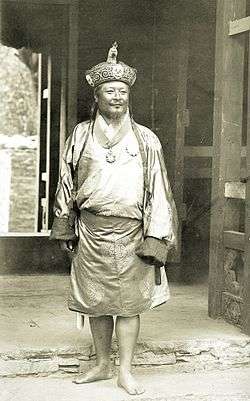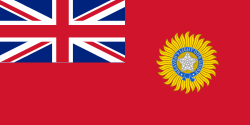Ugyen Wangchuck
| Ugyen Wangchuck | |
|---|---|
| 1st Druk Gyalpo | |
 | |
| Reign | 17 December 1907 – 26 August 1926 |
| Coronation | 17 December 1907 [1] |
| Predecessor | None (Hereditary Monarchy Created) |
| Successor | Jigme Wangchuck |
| Born |
1862 Bumthang, Wangduecholing Palace |
| Died | 26 August 1926 (aged 63–64) |
| Burial | Cremated at Kurjey Lhakhang |
| Spouse | Ashi Tsundue Pema Lhamo |
| House | Wangchuck |
| Father | Jigme Namgyal |
| Mother | Ashi Pema Choki |
| Religion | Buddhism |
Gongsa Ugyen Wangchuck (Dzongkha: ཨོ་རྒྱན་དབང་ཕྱུག, Wylie: o rgyan dbang phyug , 1862–1926) was the first Druk Gyalpo (King of Bhutan) from 1907-1926. In his lifetime he made great efforts to unite the country and gain the trust of the people.
| Kings of the House of Wangchuck | |
|---|---|
|
Ugyen Reign:1907-1926 | |
|
Jigme Reign:1926-1952 | |
|
Jigme Dorji Reign:1952-1972 | |
|
Jigme Singye Reign:1972-2006 | |
|
Jigme Khesar Namgyel Reign:2006-Incumbent | |
Life
Embattled boyhood
Ugyen Wangchuck was born in Wangdicholing Palace in 1862 and died in 1926 in Phodrang Thinley Rapten. Both of these places are in Choekhor valley in Bumthang. [2] King Ugyen Wangchuck was a farsighted statesman and strategist. He was also a pious practitioner, particularly during his later years. [3] He was apprenticed at the court of Desi Jigme Namgyal in the art of leadership and warfare at a very young age. Because he grew up in an embattled period, Ugyen Wangchuck was trained as a skilled combatant. [3] At the age of 17, he headed his troops in the battle against Paro Ponlop Tshewang Norbu. When Ugyen Wangchuck was barely 21, his father Desi Jigme Namgyel died, leaving him to strike his own role as a leader in the country. In 1885, following the death of his father, when he was 23 years old, he led 2400 troops in a series of battles that culminated in Changlimethang. [4]
Founding of Buddhist monarchy by unanimous agreement
Bhutan had been ruled under 57 successive Druk Desis for 256 years until Buddhist monarchy was established. [4] Ugyen Wangchuck founded the monarchy in 1907, although he had been more or less the actual ruler for almost a decade. [5] In British records, he is referred as the Tongsa Penlop - the ruler of Bhutan. [6] On 17 December 1907, Tongsa Penlop Ugyen Wangchuck was elected unanimously by the representatives of the people, the officials and the clergy and enthroned as the first hereditary King of Bhutan in Punakha dzong. [2]A legal document on the institution of monarchy was attested with signet-rings and thumbprints, on that day. British political officer, Sir Claude White (1853-1918), represented the British government at the enthronement ceremony. Since that day, 17 December is celebrated as the National Day of Bhutan. [6]
Foreign relations and official visits abroad
Ugyen Wangchuck, then Tongsa Penlop, joined the Younghusband Expedition to Tibet in 1904, as a mediator between Britain and Tibet. [7] His next official visit abroad took place in 1906 when he travelled to Kolkata to meet the Prince of Wales. [6]Penlop Ugyen Wangchuck was not yet formally the King, but the role he took clearly suggests that he was indeed the ruler for all practical purpose for many years before he was crowned King in 1907. King Ugyen Wangchuck’s last visit to India took place in 1911, when he went to Delhi to meet King George V (1865-1936), who was the Prince of Wales when they met earlier in 1906 in Kolkata, the seat of Viceroy of India. [6] The British Political Officer for Bhutan was Sir John Claude White until 1908 when he was succeeded by Charles Alfred Bell (1870-1945). John Claude White developed a deep respect for King Ugyen Wangchuck, and wrote: "I have never met a native I liked and respected more than I do Sir Ugyen. He was upright, honest, open and straightforward." [6] White also took the photographs at the King's 1907 coronation.[8] His Majesty King Ugyen Wangchuck was acutely conscious that Bhutan must to be protected through times of regional conflict and rivalries. His Majesty was exquisitely farsighted in updating the treaty of 1865 in 1910, with an additional clause. The new clause was that Bhutan would consult British India in its dealing with third countries. The clause was drawn up in the context of the British suspicion about the influence of the Chinese and Russians in Tibet, and beyond.
Spirituality
King Ugyen Wangchuck had close relationship with many Buddhist spiritual masters such as Lama Serkong Dorji Chang (1856-1918), Terton Zilnon Namkha Dorji, and the 15th Karmapa Khachyab Dorji (1871-1922). In 1894, aged 33, he undertook the construction of Kurjey temple, one of the landmarks of Vajrayana Buddhism in the world. The middle lhakhang in Kurjey, with its towering Guru statue, was built in 1894 by King Ugyen Wangchuck. [9] His Majesty was a great benefactor to the dratshangs (monastic bodies) throughout the country. As part of his vision for scholarship and education of young Bhutanese, he sent two groups of Bhutanese to study up to geshey level in Tibet. Twice, in 1915 and 1917, he sent batches of young monks to Zhenphen Choki Nangwa (1871-1927) in Dokham. They later returned to Bhutan and became influential geshes (doctorate level) and lamas, serving as radiant sources of Buddhist teachings. [2] One of the iconic pilgrimage centres of Buddhism is the Swayambhunath Temple in Kathmandu, a monastic enclave held by Bhutan. It was renovated mostly with King Ugyen Wangchuck’s personal funds. Kagyu Lama Togden Shacha Shri (1853-1919), with whom King Ugyen Wangchuck corresponded a great deal, supervised the renovation on behalf of King Ugyen Wangchuck. [2]
Western schools
King Ugyen's commitment was not only confined to spreading monastic education. Following his visits to Kolkata and Delhi, he began to establish schools. The first were established in Lame Goenpa and Wangdicholing, with 14 Bhutanese boys from both eastern and western Bhutan. Later, the number increased to 46. By then, students were being sent to missionary schools in Kalimpong. Those members of the first batch of students became important officials in 1930s and 1940s. King Ugyen took the initiative to sow the seeds of western education, as well as strengthen the roots of dharma in Bhutan.[10][2]
Death
In 1926, aged 64, His Majesty died in Phodrang Thinley Rabten. The Crown Prince Jigme Wangchuck was then about 23. His death was attended by miraculous signs. It was an auspicious display of the end to the extraordinary life of King Ugyen Wangchuck, who brought real stability and long lasting peace to Bhutan. [2]
Honours [11]
Foreign honours
-
 British Raj :
British Raj :
-
 Knight Commander of the Order of the Indian Empire (KCIE - 02/01/1905).
Knight Commander of the Order of the Indian Empire (KCIE - 02/01/1905). -
 Knight Commander of the Order of the Star of India (KCSI - 12/12/1911).
Knight Commander of the Order of the Star of India (KCSI - 12/12/1911). -
 Delhi Durbar Gold Medal (12/12/1911).[12]
Delhi Durbar Gold Medal (12/12/1911).[12] -
 Knight Grand Commander of the Order of the Indian Empire (GCIE - 01/01/1921).
Knight Grand Commander of the Order of the Indian Empire (GCIE - 01/01/1921).
-
Footnotes
- ↑ Royal Ark
- 1 2 3 4 5 6 dpel ‘brug zhib ‘jug lté ba (CBS) (2008). ‘brug brgyd ‘zin gyi rgyel mchog dang pa mi dwang au rgyan dwang phyug gi rtogs brjod bzhugs so (The Biography of the Second King of Bhutan Jigme Wangchuck). Thimphu: The Centre for Bhutan Studies. ISBN 978-99936-14-47-0.
- 1 2 Aris, Michael (1994). The Raven Crown: The Origins of Buddhist Monarchy in Bhutan. London: Serindia Publications. ISBN 978-193247-62-1-7.
- 1 2 Tshewang, Lama Pema (1973). A Brief History of the First Hereditary King of Bhutan.
- ↑ Sood, Shubhi (2008). Bhutan: 100 Years of Wangchuck Vision. Noida: SDS Publications.
- 1 2 3 4 5 White, J.C (1909). Sikkim and Bhutan, Twenty-One Years on the North-East Frontier 1887-1908. India: Low Price Publications. ISBN 97881-753-61-64-5.
- ↑ Allen, Charles (2004). Duel in Snows, the True Story of Younghusband Mission to Lhasa. London: John Murray Publishers. ISBN 978-0719554292.
- ↑ Hannavy, John (2013). Encyclopedia of Nineteenth-Century Photography. Routledge. p. 1496. ISBN 978-1-135-87327-1.
- ↑ Sanga, Lama (1983). Brug-tu ‘od-gsal lha’ I byung-tshul brjod-pa smyos-rabs gsal-ba’I me-long (Discourse on the Coming to Bhutan of a Lineage of the Gods of Clear: The Mirror which Illuminates the Generations the Nyo. Thimphu.
- ↑ Tobgye, Lyonpo Sonam. Education System in Bhutan – Past, Present and Future – A Reflection.
- ↑ Royal Ark
- ↑ Royal Ark
| Ugyen Wangchuck Born: 1861 Died: 26 August 1926 | ||
| Regnal titles | ||
|---|---|---|
| Preceded by None (Hereditary Monarchy Created) |
First King of Bhutan 17 December 1907 – 21 August 1926 |
Succeeded by Jigme Wangchuck |